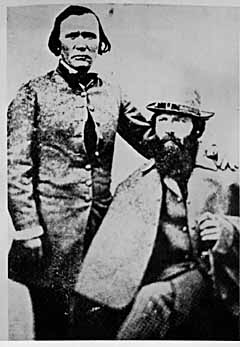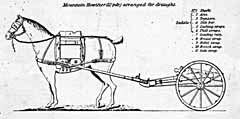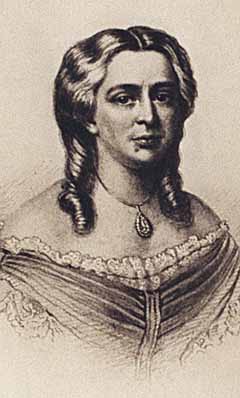John C. Fremont







Discoveries are hardly ever the work of one person, and no case shows it more clearly than the debate over who “discovered” Las Vegas for settlers of European ancestry.
Good arguments have been made for at least three different pathfinders. There was Antonio Armijo, a New Mexico merchant who in the winter of 1829-1830 organized a trading expedition to California. There was Rafael Rivera, Armijo’s scout, who probably camped in the valley before his commander.
But it was John C. Fremont who literally put Las Vegas on the map. And because more than 20,000 copies of his map were immediately published and distributed to anybody who wanted one, Las Vegas became an important stop on the way West. Mormon colonists brought wagons to Utah over his routes, and the first railroad through the region would water steam engines at springs Fremont had first made known to the world.
Elizabeth Warren, a Las Vegas historian who wrote her thesis on exploration of the region, thinks Fremont had the greatest impact, but adds that others should share the credit.
“Trade was already a fact of life before European settlers came,” noted Warren. “There is a lot of interest among archaeologists to find out if Las Vegas already served as a spot where Indians might meet periodically, or by appointment, to trade.”
Greg Seymour, archaeologist at the Harry Reid Center for Environmental Studies, said it’s clear that people traveled to and from the valley in prehistoric times. The Anasazi, more usually associated with New Mexico and Arizona, the Patayan of the lower Colorado River and the Southern Paiutes all occupied the valley. “The Southern Paiute call the Old Spanish Trail the Paiute Trail, and believe it was in use even before them.”
Mountain man Jedediah Smith probably never saw the Las Vegas Valley, yet his explorations may have brought others here.
Hoping to export Rocky Mountain fur from some Pacific port, the trapper twice led expeditions to Spanish California via Nevada’s Virgin River, northern Arizona, and the Mojave Crossing of the Colorado River, near today’s Laughlin. Both times Spanish authorities imprisoned the Americans, and on the second trip, formerly friendly Mojaves killed 10 of his men.
But one survivor of a Smith expedition, named Black, settled in Northern New Mexico. “He must have talked about that trip,” figures Warren. “Why wouldn’t he?” Or word might have circulated from the mountain men’s annual rendezvous.
“So when Armijo mounts his expedition in ’29, he leaves with the secure knowledge it can be done. You can’t otherwise account for 60 men and maybe 100 mules. This would reflect a joint venture by more than one investor; nobody has enough money to hire 60 men for a year.” The caravan was laden with trade goods.
Spanish authorities were very interested in establishing a new trail between New Mexico and California. Routes already existed through Arizona, but were too difficult.
“By the time Armijo leaves in 1829, there has been 100 years of trading with the Utes, so there were known trading trails as far as Utah.” Armijo took these for some distance, and proceeded down the Virgin River to its confluence with the Muddy.
On Christmas Day, a detachment of scouts left the party, returning on Dec. 31. On New Year’s Day, Armijo noted in his diary, “One man was missing from yesterday’s detachment … citizen Rafael Rivera.”
Rivera rejoined the group Jan. 7.
Following Rivera’s lead, the party moved into some part of the Las Vegas Valley. Warren thinks they came up the Las Vegas Wash to Duck Creek. It was the first stream they would have encountered which fed running water into marshy Las Vegas Wash, and it inclined in the general direction they needed to head. She thinks they followed it to about the location of today’s Paradise Spa, and then made a beeline for the low pass through which Interstate 15 passes. Armijo’s diary points out their next camp was at a dry lake, most probably near today’s Jean.
Rafael Rivera must have been the first non-Indian in the Las Vegas Valley, and he did it on a 14-day scout, mostly alone, into an unexplored and dangerous land. His courage is commemorated with a statue at the Rafael Rivera Community Center, near Stewart Street and Mojave Road.
Armijo inspired other caravans, but they lasted only until about 1850. And most followed variations of his route, bypassing the Las Vegas Valley.
It is an accident of history that the Las Vegas route became famous as “The Old Spanish Trail.” The accident involves one of the most remarkable adventurers of Western history — John C. Fremont.
Fremont was the son of aristocracy and of scandal. His mother, Anne Beverly Whiting, was the daughter of a member of Virginia’s pre-revolutionary ruling body, the House of Burgesses. But her father died, her stepfather squandered the estate, and in 1796 she was married off to Maj. John Pryor. Pryor was rich, well-connected — and 62 years old. She was 17.
In 1808, when Anne was 29 and her husband 74, there appeared in Richmond one Charles Fremon, who identified himself as a royalist who fled from the French Revolution. He made a living by teaching fencing and foreign languages, and by painting frescoes. By 1810 he was Anne’s lover. When Pryor discovered it, Anne and Charles fled Richmond.
Their son, John Charles Fremon, was born in Savannah, Ga., in 1813. His father died while John Charles was still a child, and after his death the family added a “t” to their last name. A brilliant student, he was always able to obtain scholarships to private schools, yet so often truant that he was expelled from college.
In 1837 the federal government decided to survey the Cherokee country of Georgia and the Carolinas. Here Fremont learned to pack a mule and what to pack on it.
He then was appointed to the U.S. Topographical Corps, and was a member of Joseph Nicolas Nicollet’s expedition to map the country between the upper Mississippi and Missouri rivers. It was Fremont’s first taste of the West.
Back in Washington by 1840, Fremont traded his stories of adventure for invitations and introductions, including Sen. Thomas Hart Benton. Fremont fell in love with Benton’s 16-year-old daughter, Jessie. The alarmed Benton expedited Fremont’s departure on another choice exploring assignment, but he came home and eloped with Jessie. Benton eventually accepted the marriage.
Benton was a leading exponent of opening the West. He knew more about it than almost anybody in Washington. But he was also a thundering bore who had trouble getting people to listen to his best ideas. Fremont, however, had the charisma and courage to put many of them into practice.
And Fremont had the timing. The United States was ready to finance an expedition to map the Oregon Trail. Nicollet was ill and would lead no more expeditions. Fremont stepped into his mentor’s shoes.
In the spring of 1842, Fremont made his way to St. Louis and began assembling the first of the expeditions that would bear his name.
He showed a talent for hiring the right men. On a chance meeting with Christopher “Kit” Carson, Fremont understood the remarkable man beneath the buckskins. Carson, at 33, had not yet learned to read nor write. Yet, he spoke French, Spanish, English, several Indian tongues, and the sign language of the plains.
Carson was one of the few mountain men who would survive Indian fights, starvation, thirst and malevolent mules, to die in bed.
He guided Fremont’s first expedition into the Wind River Valley, then swung south on his own trapping expedition. Fremont was back in Washington by October to write his report. Poetically phrased — most believe by the articulate Jessie — his reports were instant fodder for the newspapers.
In May 1843, Fremont’s second expedition was to map the area between the Rockies and the Pacific Ocean. The expedition was well-equipped and especially well-armed. The men carried breechloading rifles — though the Army would retain muzzleloaders for another 25 years.
They also dragged along a small howitzer — the “Fremont Cannon” of Nevada lore — which nearly ended the expedition before it started. The Topographical Corps didn’t need any confrontations with Mexican military in California or the British in Oregon. It sent Fremont a letter demanding he return to Washington and explain why he was taking a cannon on a peaceful, scientific expedition. Fremont’s wife intercepted the letter and, instead of forwarding it, sent him a message that he had better head west without further preparation.
The term “plausible deniability” would not come into common use for another 130 years or so, but Washington-reared Jessie Fremont understood the concept.
Fremont pushed through what is now Utah and into Oregon. Then he turned south seeking three important geographical features described by earlier explorers — the Rio Buenaventura, Klamath Lake and Mary’s Lake. He found Klamath Lake in short order but the other two, it turned out, do not exist.
By January 1844, Fremont abandoned the howitzer in heavy snowdrifts in Northern Nevada. History buffs and treasure hunters have been looking for it ever since. A copy was made and is a revolving trophy for football games between UNLV and UNR.
The expedition beat its way across the Sierra Nevada to Sutter’s Fort, arriving with only 33 of the 67 horses and mules that started the trek. Fremont then headed south to strike the Spanish Trail toward Santa Fe.
Fremont described the march in his memoirs:
“Our cavalcade made a strange and grotesque appearance, and it was impossible to avoid reflecting upon our position and composition in this remote solitude. Within two degrees of the Pacific Ocean; already far south of the latitude of Monterey; and still forced on south by a desert on one hand, and a mountain range on the other; guided by a civilized Indian, attended by two wild ones from the Sierra; a Chinook from the Columbia; and our own mixture of American, French, German — all armed; four or five languages heard at once; above a hundred horses and mules, half wild; American, Spanish, and Indian dresses and equipments intermingle; — such was our composition. Our march was a sort of procession. Scouts ahead, and on the flanks; a front and rear division; the pack animals, baggage, and horned cattle in the centre; and the whole stretching a quarter of a mile along our dreary path. In this form we journey; looking more like we belonged to Asia than to the United States of America.”
They made their way down the Mojave River, which runs only intermittently, and the cattle were growing weak from want of water and grazing. On April 24, Fremont stopped to slaughter three and dry the meat.
“In the afternoon we were surprised by the sudden appearance in the camp of two Mexicans — a man and a boy. The name of the man was Andreas Fuentes; and that of the boy (a handsome lad, 11 years old) Pablo Hernandez. They belonged to a party consisting of six persons, the remaining four being the wife of Fuentes, the father and mother of Pablo, and Santiago Giacome, a resident of New Mexico.”
The group had been herding horses from Los Angeles toward Santa Fe when it was attacked by perhaps 100 Indians, said the fugitives. “The Indians charged down into their camp, shouting as they advanced, and discharging flights of arrows … Fuentes drove the animals over and through the assailants, in spite of their arrows; and, abandoning the rest to their fate, carried them off at speed across the plain.”
Eventually, they left their horses to water at Agua de Tomaso and continued until they came upon Fremont.
Fuentes guided Fremont back over his own trail.
On April 25 Fremont’s men reached Agua de Tomaso, but the herd had been driven away. Fuentes, Carson and another scout, Alexander Godey set off in pursuit, but Fuentes turned back because his horse went lame.
“In the afternoon of the next day, a war-whoop was heard, such as Indians make when returning from a victorious enterprise; and soon Carson and Godey appeared, driving before them a band of horses, recognized by Fuentes to be part of those they had lost. Two bloody scalps, dangling from the end of Godey’s gun, announced that they had overtaken the Indians as well as the horses.”
On April 29, Fremont’s group reached the spring where Fuentes’ party had been attacked — near today’s Tecopa, on the California-Nevada border.
“The dead silence of the place was ominous,” wrote Fremont, “and galloping rapidly up, we found only the corpses of the two men; everything else was gone. They were naked, mutilated, and pierced with arrows … Of the women no trace could be found, and it was evident they had been carried off captive. A little lap-dog, which had belonged to Pablo’s mother, remained with the dead bodies, and was frantic with joy at seeing Pablo; he, poor child, was frantic with grief, and filled the air with lamentations for his father and mother. Mi padre! mi madre! was his incessant cry.”
Pablo Hernandez was adopted by Benton’s family and became a good scholar, but upon reaching adulthood returned to Mexico. The last Fremont heard of him — a report he could not verify — was that he had moved to California and become an outlaw. Fuentes became a good explorer and would accompany Fremont on another expedition.
Now that Fremont was far off the main route to New Mexico, Fuentes became his guide along the alternate. On May 1, they encamped at a spring in the mountains — probably today’s Mountain Spring. They made but 12 miles the next day, camping, probably, in the region of Blue Diamond or Oak Creek Canyon.
And on May 3: “After a day’s journey of 18 miles, in a northeasterly direction, we encamped in the midst of another very large basin, at a camping ground called Las Vegas — a term which the Spaniards use to signify fertile or marshy plains, in contradistinction to llanos, which they apply to dry and sterile plains. Two narrow streams of clear water, four or five feet deep, gush suddenly with a quick current, from two singularly large springs; these, and other waters of the basin, pass out in a gap to the eastward. The taste of the water is good, but rather too warm to be agreeable; the temperature being 71 in the one and 73 in the other. They, however, afford a delightful bathing place.”
It was all Fremont would write about the location that would become Sin City.
His departure route, to the northeast, was difficult and dangerous. “Skeletons of horses … between 50 and 60 miles without a drop of water,” he noted. “We ate occasionally the (barrel cactus) and moistened our mouths with the acid of the sour dock.”
On the Muddy River, Paiutes spotted Fremont, suspected he was raiding for slaves, and made a show of force. “They were barefooted and nearly naked; their hair gathered up in a knot behind, and with his bow, each man carried a quiver with thirty or forty arrows partially drawn out. Besides these, each held in his hand two or three arrows for instant service. Their arrows are barbed with a very clear translucent stone, a species of opal, nearly as hard as the diamond; and shot from their long bow, are almost as effective as a gunshot,” he wrote. Fremont negotiated peace here, but on the Virgin River, a day’s march further northeast, one man fell behind and was never seen again. Those who tracked him found signs of struggle and death.
Yet for all its dangers, the route through Las Vegas became well traveled, simply because it became well-known. Congress printed 20,000 copies of Fremont’s 1845 report of this trip and its map. “This meant anybody who wanted one could have it,” said Warren. “It became so important that if a group of emigrants did NOT have one, that fact would be mentioned in diaries.”
In “Mapping the Transmississippi West,” Carl L. Wheat explained why. “To the extent that the map did cover the West, almost uniformly it represented trustworthy direct observation, a new, welcome, and long overdue development in the myth-encrusted cartography of the West … This is an altogether memorable document in the cartographic history of the West, and for it alone Fremont would deserve to be remembered in history.”
Of course, Fremont would be remembered for a good deal more, not all of it good. For instance, he helped provoke the Bear Flag Rebellion which culminated in the United States’ acquisition of California in the Mexican War.
Arriving in California in 1846, on what was supposed to be another scientific expedition, he was ordered to leave by the Mexican government. Instead, he took up a position on a hilltop, daring the Mexicans to attack. Fremont instigated several attacks by armed settlers and then took command of Sutter’s Fort.
California would soon fall. Fremont was court-martialed for incidents growing out of his high-handed conduct in California, and dismissed from the Army. But President James Polk, recognizing a popular hero and one with an important senator on his team, canceled the dismissal. Fremont resigned anyway, and continued his explorations with private backing.
Such a hero was Fremont that leading Democrats offered to back him if he would seek the party’s nomination for president in 1856. There were some conditions attached, however; one was that Fremont endorse the Fugitive Slave Act, which said that slaves who had managed to escape to nonslave states could be forced back into slavery. Fremont would not swallow that. Thus he became, instead, the first candidate fielded by the new Republican Party.
Against such a popular hero, Democrats leveled every gun. They fairly brought up his high-handed conduct in California and his unsuccessful business deals. Unfairly, they called him a drunk; he was very nearly a teetotaler. They accused him of being a Catholic, which was also untrue, but Fremont refused to deny it because denial would imply there was something wrong with being one.
Buchanan carried 19 states to Fremont’s 11. Millard Fillmore, who ran under the Know-Nothing banner, carried one state.
After the outbreak of the Civil War, President Abraham Lincoln made Fremont a general. Appointed commander of the Department of the West, Fremont promptly issued his own emancipation proclamation in August 1861. It only applied in Missouri, but the threat of such a proclamation was the strongest hole-card Lincoln held in trying to end the war, and he didn’t appreciate Fremont playing it without asking him. He watered down Fremont’s order and eventually transferred him East. There Fremont was outgeneraled by Stonewall Jackson, and resigned before the war ended.
Fremont had become wealthy by purchasing real estate in California’s early days, but by 1870 he had lost it all in litigation over mining rights and a failed railroad venture.
The family’s unfamiliar poverty was relieved somewhat by Jessie’s emergence as a popular author. Fremont himself was appointed governor of Arizona Territory from 1878 until 1881, when he moved back to New York to seek financing for various ideas to develop the West. His last home was in Los Angeles. On a visit to New York City in July 1890, Fremont fell ill with peritonitis, possibly resulting from a ruptured appendix, and quickly died of it. At his own orders he was buried in a plain coffin and a civilian suit.
History adopted as his epitaph one short phrase attributed to Benton:
“From the ashes of his campfire have sprung cities.”
Part I: The Early YearsPart II: Resort Rising
Part III: A City In Full












